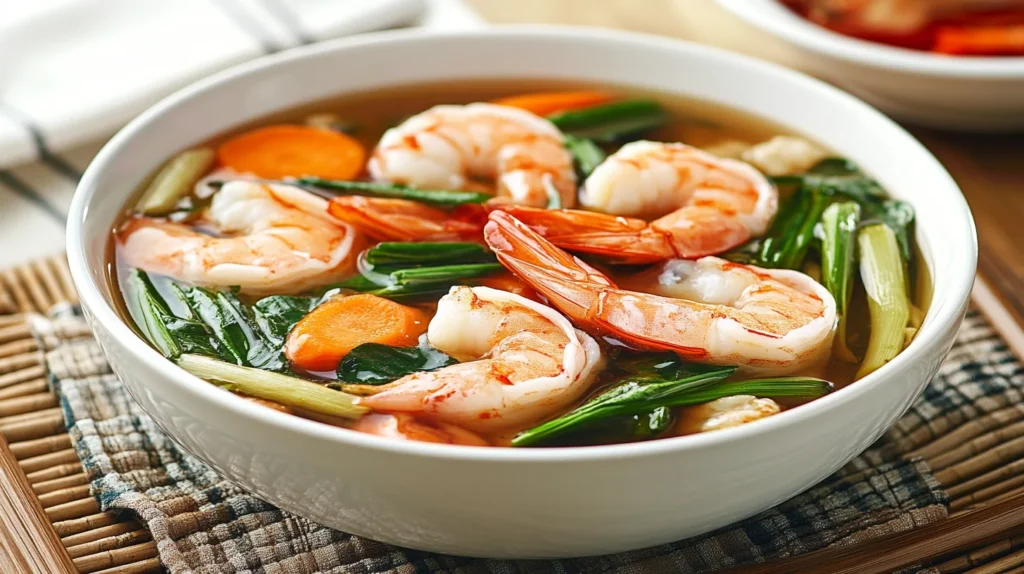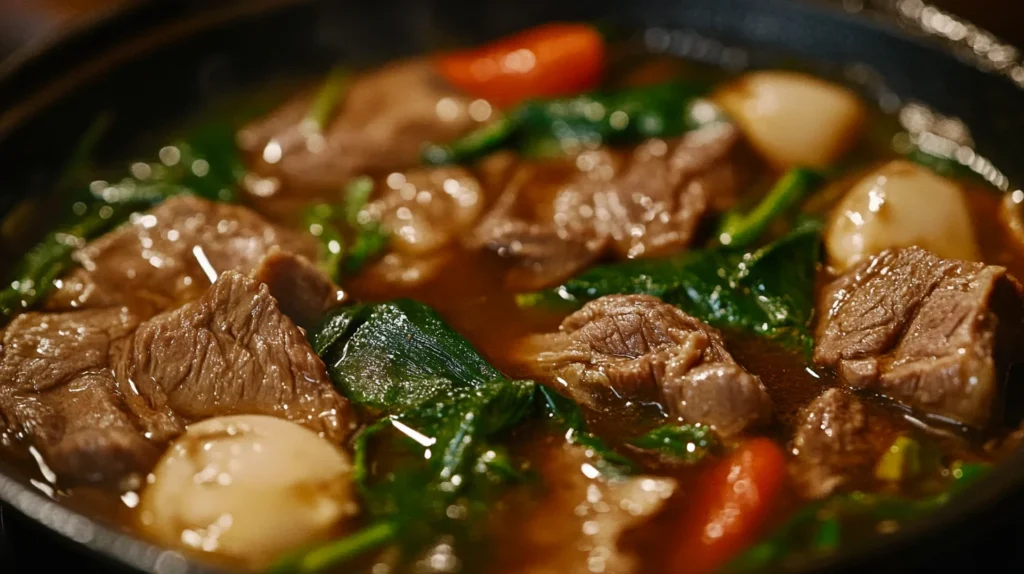Table of Contents
What is Sinigang Recipe?
Origin and History
Sinigang Recipe, a Filipino sour soup, is one of the most iconic dishes in the country’s culinary heritage. Its name comes from the Tagalog word “sigang,” meaning “to stew,” reflecting its slow-cooking process that enhances flavor and tenderness. The dish is believed to predate Spanish colonization, with early Filipinos using indigenous ingredients like tamarind, kamias, and guava to create the soup’s signature sour flavor.

Traditionally cooked over wood or charcoal, Sinigang evolved with influences from neighboring Asian cuisines while maintaining its distinctively Filipino identity. The broth, rich in natural acidity and umami, symbolizes the simplicity of Filipino home cooking. Each region in the Philippines has its own version, highlighting local produce and cultural preferences.
For a similar slow-cooked flavor, check out our recipe for Country-Style Beef Ribs, which offers a hearty meal perfect for family gatherings.
Why Sinigang Recipe is Loved
Sinigang Recipe is adored not just for its unique taste but also for the emotions it evokes. Its sourness provides a refreshing contrast to the tropical heat of the Philippines, while its warmth makes it perfect for rainy days. Filipinos find comfort in its flavors, which are deeply tied to family traditions and gatherings.
Moreover, Sinigang is versatile. It can be prepared with various proteins like shrimp, beef, or fish, and adapted with different souring agents to suit the cook’s palate. Its health benefits—thanks to its vegetable-rich ingredients—make it a beloved option for those seeking both nourishment and flavor.
Key Ingredients for Sinigang Recipe
Protein Options
The choice of protein determines the character of your Sinigang. Here are some popular options:
- Shrimp (Sinigang na Hipon): This lighter alternative adds a subtle sweetness that complements the tangy broth. Use fresh, head-on shrimp for the best flavor.
- Beef (Sinigang na Baka): Often made with short ribs or brisket, beef Sinigang Recipe has a robust and hearty profile.
- Fish (Sinigang na Isda): Milkfish (bangus) or salmon are common choices for a cleaner, lighter soup.
Each protein imparts a unique taste and texture, making Sinigang endlessly customizable.
Essential Vegetables
Vegetables in Sinigang not only add color but also boost the soup’s nutritional profile. Common vegetables include:
- Radish (Labanos): Adds a mild bitterness that balances the sourness of the broth.
- Eggplant (Talong): Soaks up the flavors of the soup, providing a soft, creamy texture.
- Okra: Known for its slightly slimy consistency, okra helps thicken the broth naturally.
- Water Spinach (Kangkong): A leafy green that softens quickly, making it a must-have for an authentic Sinigang experience.
For ideas on incorporating similar vegetables into your diet, explore our Sweetgreen Harvest Bowl Recipe.
Tamarind and Sour Alternatives
Tamarind is the soul of Sinigang, providing its signature tangy flavor. However, if tamarind is unavailable, these substitutes work well:
- Kamias (Bilimbi): A small, green fruit that delivers a sharp sourness.
- Calamansi (Philippine Lime): Adds a citrusy tang that brightens the broth.
- Guava: Used in Sinigang sa Bayabas, it adds a mildly sweet and fruity flavor.
- Commercial Sinigang Mix: A convenient option, these mixes replicate the tamarind flavor while incorporating other seasonings for a balanced taste.

Kitchen Tools You’ll Need
Must-Have Utensils
To make Sinigang Recipe at home, you’ll need:
- Stockpot: A large, sturdy pot for boiling the broth and simmering the ingredients.
- Knife and Cutting Board: For prepping vegetables and protein.
- Ladle: Essential for stirring and serving the soup.
Alternative Tools
For outdoor enthusiasts, cooking Sinigang in a Dutch oven enhances its rustic appeal and depth of flavor. Dutch ovens provide even heat distribution, making them perfect for stews and soups.
Step-by-Step Guide to Making Sinigang Recipe
Creating a delicious pot of Sinigang is a straightforward process that combines fresh ingredients and simple techniques. Follow this guide to ensure a flavorful and satisfying bowl of this Filipino classic:
Preparing the Ingredients
- Wash and Prep Vegetables: Thoroughly rinse all vegetables to remove dirt. Cut them into bite-sized pieces:
- Slice radish into thin rounds.
- Cube eggplant.
- Trim the ends of okra.
- Separate water spinach leaves from the stalks.
- Portion the Protein: Cut beef, fish, or shrimp into serving-size pieces. If using beef, opt for belly or ribs to maximize flavor.
Pro Tip: Using fresh, high-quality ingredients is essential for the best-tasting Sinigang. For guidance on ingredient prep, explore our Sourdough Breakfast Recipes for tips on working with fresh produce.
Cooking the Base
- Sauté Aromatics:
- Heat a large stockpot over medium heat and add a splash of oil.
- Sauté sliced onions and chopped tomatoes until soft and fragrant.
- Start the Broth:
- Add the prepared protein to the pot and sear briefly to lock in the flavor.
- Pour in enough water to cover the meat and bring it to a boil. Skim off any foam or impurities that rise to the surface for a clear broth.
Adding Protein and Vegetables
- Cook the Protein: Simmer the protein gently until tender. This takes approximately:
- 45-60 minutes for beef.
- 10-15 minutes for shrimp or fish.
- Add the Vegetables: Introduce vegetables in stages based on their cooking time:
- Start with radish and green beans, as they take longer to soften.
- Add okra and eggplant next.
- Finish with water spinach, which cooks in just 1-2 minutes.
Adjusting the Flavor
- Incorporate Tamarind or Sour Agent: Stir in tamarind paste or Sinigang mix. Taste the broth and adjust the sourness by adding more tamarind if desired.
- Season with Fish Sauce: Add fish sauce (patis) or salt to enhance the umami and depth of the broth.
- Balance the Flavor: If the soup is too sour, add a little water or a pinch of sugar to balance the taste.
Pro Tip: Taste the broth frequently and adjust the seasoning to your preference. The perfect Sinigang is a balance of sour, savory, and slightly salty flavors.
By following these steps, you’ll create a pot of Sinigang that’s bursting with flavor and packed with nutrients. Serve it hot with a side of steamed rice for an authentic Filipino meal that’s sure to impress! For a rustic twist, try cooking it in a Dutch oven for deeper, smokier flavors.

Tips for Perfecting Sinigang Recipe
Balancing Flavors
A perfect Sinigang balances sour, salty, and umami flavors. Taste as you go, and don’t be afraid to tweak the proportions of tamarind, fish sauce, and salt.
Customizing for Diets
- For a healthier version, use lean proteins like chicken breast or fish.
- Vegetarian options include tofu and mushrooms, paired with vegetable broth for richness.
Presentation Tips
Serve Sinigang in a deep bowl, garnished with fresh greens like kangkong, and pair it with steamed rice for a traditional meal.
Common Variations of Sinigang Recipe
Sinigang’s adaptability is one of its defining features. While the essence of the dish remains constant—its sour and savory broth—variations arise from the choice of protein and other ingredients. Here are three popular versions that showcase the diversity of Sinigang:
Sinigang na Baboy
The tangy tamarind-based soup is complemented by a medley of vegetables like labanos (radish), talong (eggplant), and kangkong (water spinach). For best results, serve this dish hot alongside steamed white rice, which absorbs the flavorful broth beautifully.
For those seeking other hearty and meaty dishes, try our Country-Style Beef Ribs Recipe for a satisfying meal.
Sinigang na Hipon
Sinigang na Hipon, or Shrimp Sinigang, offers a lighter, seafood-focused alternative. This version highlights the natural sweetness of shrimp, which pairs beautifully with the sour broth. Fresh, head-on shrimp is recommended for the best flavor, as the heads and shells add richness to the soup.
Vegetables commonly used in this variation include okra, green beans, and tomatoes. The quick cooking time of shrimp makes this dish ideal for busy days when you need a nutritious yet delicious meal in minutes.
For more seafood-inspired recipes, explore our Boom Boom Shrimp Recipe for a unique take on shrimp dishes.
Vegetarian Sinigang
Vegetarian Sinigang is a plant-based version that retains all the comforting flavors of the original. Instead of meat, this version uses protein-rich alternatives like tofu or mushrooms, paired with vegetable broth for a hearty base.
The medley of vegetables takes center stage in this dish, with choices like eggplant, radish, kangkong, and even sweet potatoes for a slight twist. For added tanginess, tamarind or guava remains the key souring agent. This dish is perfect for those following vegetarian or vegan diets, offering both flavor and nutritional benefits.
For more vegetarian inspirations, check out our Sourdough Breakfast Recipes to start your day on a healthy note.
Nutritional Benefits of Sinigang Recipe
Sinigang is not only a flavorful dish but also a nutritious one, making it a favorite for those seeking wholesome comfort food. Its combination of protein, vegetables, and souring agents creates a meal packed with essential nutrients. Here’s a breakdown of its health benefits and nutritional profile:
Health Benefits of Ingredients
The ingredients used in Sinigang are both nourishing and satisfying:
- Tamarind: The key souring agent, tamarind is rich in antioxidants, vitamin C, and magnesium. It supports digestion, boosts immunity, and has anti-inflammatory properties.
- Vegetables:
- Radish (Labanos): High in fiber, aiding digestion, and low in calories.
- Eggplant (Talong): Contains antioxidants like nasunin, which support brain health and reduce free radical damage.
- Okra: Packed with vitamin C, folate, and soluble fiber, which helps regulate blood sugar.
- Water Spinach (Kangkong): A rich source of iron, calcium, and vitamin A, promoting strong bones and good vision.
- Protein: Whether you use beef, shrimp, fish, or tofu, the protein in Sinigang helps repair and build muscle while keeping you satiated.
Calories and Macronutrients
Sinigang Recipe is relatively low in calories compared to other comfort foods, making it a guilt-free indulgence. While the nutritional breakdown depends on the specific ingredients and portion sizes, here’s a general overview:
- Calories: A typical bowl of beef Sinigang contains around 250-300 calories, depending on the fat content of the meat. Shrimp or fish-based versions are even lighter, averaging 150-200 calories per serving.
- Protein: Each serving provides a significant amount of protein, ranging from 15g to 25g, depending on the protein source.
- Carbohydrates: The broth and vegetables contribute to the dish’s carbohydrate content, typically around 10-15g per serving, mostly from dietary fiber.
- Fats: Beef-based Sinigang contains healthy fats from the meat, while vegetarian or seafood versions are much lower in fat.
The soup’s reliance on fresh ingredients and minimal oil makes it an excellent choice for those monitoring their caloric intake or looking for a nutrient-dense meal.
For a balanced diet, consider pairing Sinigang with dishes like our Sourdough Breakfast Recipes to add a unique texture and additional nutrients to your meal.
Frequently Asked Questions About Sinigang Recipe
What are the main ingredients of Sinigang?
Sinigang’s core ingredients include:
Protein: shrimp, fish, or beef.
Vegetables: Radish (labanos), eggplant (talong), okra, water spinach (kangkong), and green beans (sitaw).
Souring Agent: Tamarind is the traditional choice, but alternatives like guava, calamansi, or kamias can also be used.
Seasonings: Fish sauce (patis), salt, and pepper enhance the dish’s savory profile.
Is Filipino Sinigang healthy?
Yes, Sinigang Recipe is a healthy dish! It is packed with:
Nutrients from vegetables: Radish, kangkong, and okra are rich in vitamins and minerals, including vitamin A, C, and iron.
Lean protein: The use of beef, fish, or shrimp provides essential amino acids for muscle repair and growth.
Low-calorie and low-fat options: Variations like shrimp or fish Sinigang offer lighter alternatives.
The broth’s high water content makes it hydrating and filling, while the dish’s minimal use of oil keeps it heart-healthy.
What is Sinigang mix made of?
Sinigang mix is a convenient, ready-made powder that replicates the sour and savory flavors of traditional Sinigang Recipe. Its ingredients typically include:
Tamarind extract (the primary souring agent).
Salt and spices for seasoning.
MSG or other flavor enhancers to replicate the umami taste of fresh ingredients.
What is the alternative for Sinigang mix?
If Sinigang mix isn’t available, you can use fresh or natural souring agents, such as:
Tamarind paste or fresh tamarind pods
Calamansi juice
Kamias (bilimbi)
Guava (for a slightly sweet twist)
These alternatives provide a more authentic flavor and are free from preservatives or artificial additives.
What is the English term for Sinigang?
Sinigang is often referred to in English as “Filipino sour soup.” This name highlights its defining characteristic: the tangy, savory broth created by the souring agent.
Why do Filipinos love Sinigang?
Filipinos love Sinigang for several reasons:
Comfort and Nostalgia: It is a staple in Filipino households, evoking memories of family meals and celebrations.
Versatility: The dish can be customized with different proteins and vegetables to suit individual tastes.
Refreshing Flavor: The sour broth is uniquely satisfying, especially in the Philippines’ tropical climate.
Health Benefits: Sinigang’s fresh ingredients and light preparation make it a guilt-free indulgence.
Sinigang is not just a dish; it’s a cultural experience that represents Filipino hospitality and culinary ingenuity.
Final Thoughts
Why Everyone Should Try Sinigang Recipe
Sinigang is more than just a dish; it’s a journey into the heart of Filipino culture. Its unique combination of sourness, umami, and freshness makes it a standout in global cuisine. Whether you’re exploring it for the first time or revisiting a childhood favorite, Sinigang offers a comforting yet vibrant dining experience.
- Versatility: With variations like beef, shrimp, or even vegetarian options, there’s a Sinigang for every palate and dietary preference.
- Health Benefits: Packed with fresh vegetables, lean proteins, and natural souring agents, Sinigang is a nutritious and well-balanced meal.
- Cultural Connection: Every bowl of Sinigang tells a story of tradition, family, and Filipino hospitality.
Embracing Filipino Cuisine
Trying Sinigang Recipe is an invitation to embrace Filipino cuisine, a culinary treasure rich in history and diversity. It showcases the Filipino love for bold and balanced flavors, using simple, fresh ingredients to create something extraordinary.
By incorporating Sinigang into your meals, you’re not only enjoying a delicious dish but also supporting a deeper appreciation for Filipino culture and its culinary heritage. Pair it with other Filipino classics or experiment with your own twist to make it a staple in your home.
Sinigang Recipe is a dish that transcends borders, offering a taste of the Philippines to food lovers around the world. Whether served in a bustling Filipino household or a quiet dinner table abroad, it never fails to bring warmth, joy, and connection.
So why wait? Gather your ingredients, follow the recipe, and savor the magic of Sinigang today!
Print
Sinigang Recipe: A Filipino Comfort Food Classic
- Total Time: PT1H15M
- Yield: 4 servings
- Diet: Gluten Free
Description
A classic Filipino sour soup (sinigang) made with tamarind-based broth, fresh vegetables (like radish, eggplant, okra, and water spinach), and your choice of protein (beef, shrimp, or fish)
Ingredients
Protein Options
-
Shrimp (Sinigang na Hipon): Light and subtly sweet; best with fresh, head-on shrimp.
-
Beef (Sinigang na Baka): Hearty and robust, often using short ribs or brisket.
-
Fish (Sinigang na Isda): Light and clean flavor; milkfish (bangus) or salmon are common.
Essential Vegetables
-
Radish (Labanos): Mildly bitter, balances the sourness.
-
Eggplant (Talong): Absorbs broth well, giving a creamy bite.
-
Okra: Slightly slimy texture, helps thicken the soup.
-
Water Spinach (Kangkong): Tender leafy green, a staple in traditional Sinigang.
Tamarind & Sour Alternatives
-
Tamarind: Classic souring agent, gives signature tang.
-
Kamias (Bilimbi): Sharp and sour substitute.
-
Calamansi: Citrusy, brightens the broth.
-
Guava: Adds mild sweetness (used in Sinigang sa Bayabas).
-
Commercial Sinigang Mix: Easy-to-use blend that mimics tamarind flavor with added seasonings.
Instructions
Preparing the Ingredients
-
Wash and Cut Vegetables:
-
Slice radish into thin rounds
-
Cube eggplant
-
Trim okra ends
-
Separate water spinach leaves from stems
-
-
Portion Protein:
-
Cut beef, fish, or shrimp into serving-size pieces
-
Use beef belly or ribs for richer flavor
-
Cooking the Base
-
Sauté Aromatics:
-
Heat oil in a stockpot
-
Sauté onions and tomatoes until soft and fragrant
-
-
Start the Broth:
-
Add protein and sear briefly
-
Pour water to cover and bring to a boil
-
Skim off foam for a clear broth
-
Adding Protein and Vegetables
-
Simmer Protein:
-
Beef: 45–60 minutes
-
Shrimp/Fish: 10–15 minutes
-
-
Add Vegetables in Stages:
-
Radish and green beans first (longer to soften)
-
Okra and eggplant next
-
Finish with water spinach (1–2 minutes to cook)
-
Adjusting the Flavor
-
Add Tamarind or Sour Agent:
-
Use tamarind paste or commercial Sinigang mix
-
Taste and adjust sourness as needed
-
-
Season with Fish Sauce:
-
Add fish sauce (patis) or salt for depth
-
-
Balance the Taste:
-
If too sour, add water or a pinch of sugar
-
Notes
Comforting and nourishing—simple, flavorful, and perfect for family meals. The sour broth is balanced by fish sauce, and the recipe is highly adaptable to different proteins and souring agents .
- Prep Time: PT15M
- Cook Time: PT60M
- Category: Soup / Main Course
- Method: Stewing / Simmering
- Cuisine: Filipino

